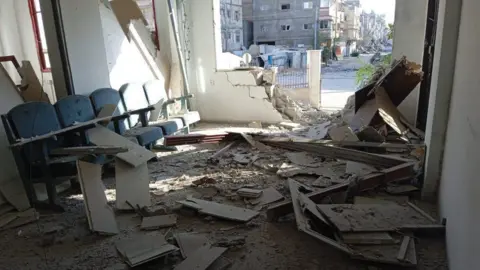The humanitarian crisis in Gaza continues to escalate, underscored by a devastating event reported by the Palestine Red Crescent Society (PRCS). An attack by Israeli military forces on the organization’s headquarters in Khan Younis resulted in the death of one of its workers, Omar Isleem, while three others sustained injuries. The PRCS condemned this incident, asserting that the assault was intentional and categorized it as a blatant violation of humanitarian norms which call for the protection of medical and emergency personnel.
On Sunday morning, an artillery strike targeted the upper floors of the PRCS headquarters, allegedly leading to a fire that engulfed part of the building. The organization, which is well-versed in the perilous dynamics of conflict zones, emphasized that their facility’s location was known to the Israeli military and clearly marked with the internationally recognized red crescent emblem. This emblem is crucial as it signifies the building’s function as a humanitarian space, ostensibly protected from attacks under international law.
In response to the strike, the Israel Defense Forces (IDF) indicated that they were reviewing the situation and investigating the claims made by the PRCS about the targeted nature of the attack. The IDF acknowledged that unassociated individuals in the vicinity may have been affected during their military operations, which have increasingly concentrated on the Gaza region amidst ongoing hostilities.
Footage circulated on social media depicted the PRCS headquarters engulfed in flames, with clouds of smoke billowing from its windows. Initial accounts from the aid agency described how after the first strike, PRCS personnel were attempting to evacuate remaining staff and assess the building’s damage when a subsequent strike hit the second floor directly, further hampering rescue efforts. Despite enduring a catastrophic blow, the PRCS reiterated its commitment to accountability and called for stronger measures to safeguard humanitarian workers in conflict areas.
The implications of this attack are not isolated events, as the PRCS reported a staggering toll of 51 of its staff members and volunteers killed since the onset of the escalation in hostilities. This statistic reflects the broader humanitarian crisis gaining urgency, particularly as the United Nations Human Rights office expressed profound shock at the ongoing killings of emergency workers trying to provide vital assistance in Gaza.
The situation in Gaza has reached alarming heights, with reports indicating continuous fatalities amidst the military offensive. The Hamas-run Gaza health ministry announced that at least 104 individuals had been killed by Israeli air and ground strikes in just a single 24-hour period, emphasizing that many of these casualties were civilians. Tragically, the lack of immediate access to food aid has also led to deaths from malnutrition, with recent figures highlighting that at least 175 individuals have succumbed to starvation-related issues.
As the humanitarian crisis deepens, the previous blockade imposed by Israel, now partially lifted, is still insufficient to meet the overwhelming needs of the civilian population in Gaza. Medical facilities are reporting critical shortages of essential supplies. The relentless conflict has seen 60,839 people killed, many of whom were trying to secure basic necessities, like food and medical care.
Despite international calls for increased humanitarian aid, the IDF continues to engage in military actions alleging that Hamas uses civilian areas to launch assaults, complicating the already fraught situation. Recent collaborative efforts by the IDF and various international partners have resulted in some aid drops; however, many claim that this is not nearly enough to stave off the looming humanitarian disaster.
As the conflict endures, the interplay of military action and humanitarian needs pits civilian safety against the backdrop of ongoing strife, calling for urgent dialogue and resolutions to the escalating violence in the region to prevent further loss of life. The humanitarian landscape remains critical, and the plight of many innocents caught in the crossfire must not be overlooked in the pursuit of peace.












